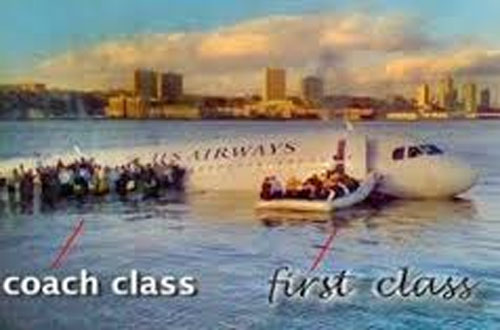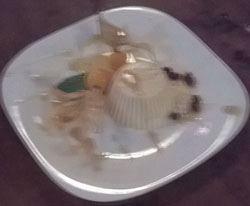|
|
|---|---|
Edition 79- March 2015 Published at Quepos, Province of Puntarenas, Costa Rica (© Copyright 2015 - All Rights Reserved) |
Broken News
(All the News That's Fit to Reprint)
Feral Cats and Crocs
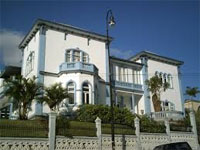 |
Home of the Costa Rican Asamblea Legislativa |
It seems that the Asamblea Legislativa, the unicameral congress of Costa Rica, is beset by a group of feral cats that keep multiplying under its auspices (or, more precisely, under its floor in the cellar). GG was uncertain of what the term feral meant so I looked it up - see feral in what's-in-a-word below for a definition.
This is serious - how can your government representatives be busy raising taxes and achieving 50% deficit spending levels if one is distracted continuously by a cacophonous chorus of meowing carnivores?
 |
"You're Not Cutting Me Without a Fight, Señor!" |
The 57 politicos (diputados and diputadas) in the Asamblea had an answer; "we'll castrate the little devils" they announced in the press. Of course that would help; at least partially (its possible the term castration was a mistranslation from Spanish and they really meant it as the more generalized term of sterilization).
But GG wondered what they were going to do about the females? Would those uncut gatitas not still be subject to the amorous advances of other, non-snipped tomcats, say some future assembly-bound pussies for example?
Stay tuned for more progress reports on cat-nipping, our crack reporting team will be there..
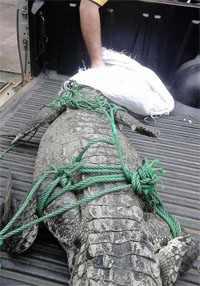 |
Meanwhile, Quepos was having it's own problem with stray animals. But down here in the rainforest the type of feral carnivore one encounters can be quite different. A few weeks ago a couple of crocs were found wandering the alleys and streets of our picturesque hamlet. Check out the little fellah in the photo to the left they caught perambulating the town - isn't he cute? This croc measured in at 2.5 meter/8.3 ft, 200 kg/440 lb. Our reptilian friend was gently escorted back to the swamp.
Crocodiles are primarily nocturnal and stay in or near water, particularly rivers where they can feed on insects, crustaceans, snails, small fish, frogs, and tadpoles. But they have been known to travel several kilometers over land. And although older crocodiles mainly eat fish, they are more apt to prey upon waterfowl and small to medium sized mammals than their juniors.
Its not difficult to find someone in the Quepos area who has had an experience where a frisky or hungry croc has attacked or may even have killed a pet, like a dog or cat. And while attacks on humans are much more uncommon, they do occur; just ask Omar de Jesus Jiron. Oh sorry, you can't ask Omar any more, he decided to go swimming with the crocs in the Rio Tarcoles north of Jacó one night in a drunken stupor and a few days later his head was mistaken for a washed up coconut on a beach north of Jacó. In English, we call that kind of midnight swim a bad idea Omar.
Hey, maybe that's the answer to the Asamblea problem; we send our Diputados a couple of our feral crocs and they can put them to work on their own purring ferals.
Once More Ortega Stirs It Up
In 2011, a new inter-american organization was created to compete with the Organization of American States, the OAS having been formed in 1962 at the urging of the Kennedy administration in order to have a forum to address cooperation and conflict in the Americas, namely the countries making up North America, South America and the Caribbean.
The new organization created in 2011 is called Comunidad de Estados Latinoamericanos y Caribeños (Community of Latin American and Caribbean States) or CELAC. It was formed and encouraged by those who felt OAS was dominated by U.S. interests. CELAC has virtually the same country members as OAS with the notable exception of the U.S. and Canada not being invited to join CELAC and the fact that Cuba, a member of CELAC, had first been refused OAS membership and later declined to join when invited. The two missing north american countries account for slightly more than a third of the total population in the Americas.
Less than two-thirds of the population in CELAC countries speak Spanish as a home language. The 33 countries in CELAC speak 4 different languages, to wit:
Eighteen Spanish-speaking countries (56% of the area, 63% of the population)
One Portuguese-speaking country (42% of the area, 34% of the population)
One French-speaking country (0.1% of the area, 1.6% of the population)
Twelve English-speaking countries (1.3% of the area, 1.1% of the population)
In January of this year it was Costa Rica's turn to host CELAC in San José. A minor flap occurred when Nicholas Maduro of venezuela showed up voicing concerns about his own safety (things are not great in Venezuela at this time) and proceeded to drive himself in one of his own embassy's cars to his hotel, Nicki, driving by yourself from Juan Santamaria airport to downtown San José might also be deemed a risk by many, amigo. The economy is in very bad shape in Venezuela with high inflation, food shortages and a plummeting oil price that means lower tax revenues. Maduro was evidently concerned that some angry Venezuelan ex-pats in Costa Rica might be after him but nothing came of it.
 |
January 2015 CELAC Attendees: 1-Solis of Costa Rica, the Host; 2-Raul Castro - Cuba; 3-Daniel Ortega - Nicaragua; 4-Nicolás Maduro - Venezuela and 5-Dilma Rousseff of Brazil. |
But Danny Ortega, the president of Nicaragua, caused the biggest flap when he brought along a guest, a fellow named Rubén Berríos, who happens to be the head of the Puerto Rican Independence Party. Puerto Rico is not represented at CELAC of course (nor for that matter in OAS), because at this time the country is a territory of the U.S. Ortega sat Berrios at the table as if he were a head of state and a strong discussion ensued about Puerto Rican independence (even though four referendums in the country have so far failed to pass; the last 54% NO to independence (but 61% YES for statehood).
The move by Ortega irritated the conferences host, Costa Rican prez Solis. Of course relations between Ortega and Solis have not been very good ever since Nicaragua expropriated a chunk of Costa Rica land called Isla Calero in the far northeastern corner of Ticoland back in October of 2010. That issue was not brought up at the conference but it still remains an open case in the World Court in the Hague.
Quepo en Quepos, Quepos
A few years ago when I was studying Spanish (some would say to mixed results) my teacher told me about an interesting verb conjugation. The verb caber means to fit in or be contained in. The first person, singular of the verb is quepo (phooey on those Spanish verb stem changes). Soon afterwards I had a t-shirt made up that says QUEPO EN QUEPOS, which simply means "I fit in Quepos". At least it means that to me although I have to say only about half the Ticos I meet while wearing the shirt get the implication. (I could say Yo Quepo in Quepos for emphasis but the first person conjugation is technically OK by itself without the personal pronoun)
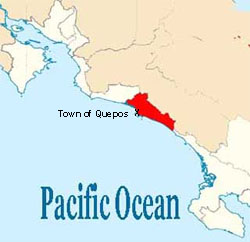 |
Quepos Town and Canton (red) |
Now word comes from the Asamblea Legislativa that a bill has been passed changing the name of the Canton (similar to county) in which Quepos is situated from Aguirre to Quepos. The name Aguirre refers to Rolando Aguirre Lobo, a soldier of the famed Legión Caribe, who died in the 1948 civil war fighting the battle of Limón. The authorities were quick to point out that they meant no disrespect to Aguirre but that both citizens and visitors alike relate better to the name Quepos because it is an existing physical place.
So now both the largest town in the canton and the canton itself will carry the name Quepos. Therefore I can now say accurately in Spanish "Quepo en Quepos, Quepos" (rather than Quepo en Quepos, Aguirre). I doubt whether I'll get a new t-shirt just yet but I will continue to encourage the Municipality of Quepos to adopt my slogan, Quepo en Quepos as their motto. ¡Vamos, amigos!
Of course, if we wanted to get the province into the act, the t-shirt would have to say Quepo en Quepos, Quepos, Puntarenas.... whoa, settle down big guy, you're getting out of control.
Note: The word Quepos derives from the name of a tribe of pre-Colombian indigenous natives ("indians") called the Quepoas who lived in this area and who slowly became extinct after the arrival of the Spanish in the 1800's.
¡Solo Bueno!
Rumble Talk
(Shaky Happenings On or About the Pacific Rim)
Shhhhhhh, nothing's happening. Is that great, or is it eerie?
| Check Out Recent Earthquakes Around the World Posted by the U.S. Geodetic Survey: Today's Quakes |
|---|
Costa Rican Tamales
(The Maize Craze - a Satisfying Tradition)
As the Christmas and New Year's holidays approach in Costa Rica, a special food starts to appear in shops, with street vendors, at fresh market stalls and in the homes.
Tamales may not have been invented here but they are a popular, even cherished, traditional food at the end of the calendar year. GG was walking about Quepos a few days before this past Christmas when a good Tico friend approached him with a smile and gave him a Christmas gift, a small package containing two tamales that were made in Quepos. How thoughtful, and timely, as I had been wanting to try them for some time but never got around to actually buying some. Not many people eat tamales in New England where the golden one grew up or in places where he had lived before like eastern Pennsylvania, southeastern Ohio, Belgium or even the west coast of Florida - although the southeast coast of Florida is probably quite familiar with them.
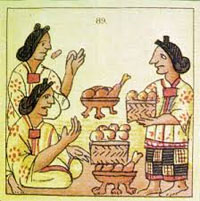 |
Native Women on the War Path with Tamales (and Other Stuff) |
So I knew nothing of how a tamale is made or even how it tastes. I always thought they were Mexican in origin and guess what, I may have lucked out on that one. Tamales (the singular form of which is tamal) are shown in native drawings as far back as 5,000 BC and in Aztec and Mayan records. They were a food staple that could be made on the road, so war parties always brought along their women to make and feed them food, easy to make concoctions that included tasty tamales (behind every good warrior is a clever women tamal maker).
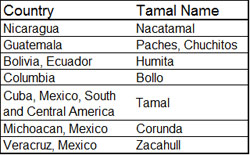 |
But these tasty little devils have evolved and taken on different names in different countries over the eons. The basic list of names is given in the table to the right. For the remainder of this report, we'll use the Central American form "tamal(es)".
And tamales, like good books, come in different wrappers. In Mexico where corn predominated, tamales are wrapped in corn husks but in Costa Rica, where there are many more bananas and plantain plants, tamales come wrapped in those leaves. (no, Dorothy, you don't eat the wrapper, it's quite tough and indigestible - just ask GG!). One simply steams them or places them in simmering water to heat them to perfect eating temperature, then unwraps the carrier and discards it, focusing on the doughy goodness inside. Yummers.
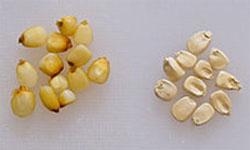 |
Untreated Corn vs Hominy, i.e. Unground Masa |
Making tamales involves a couple of steps. The outside of a tamal is a corn dough made from a flour called masa harina. Masa harina is made by taking corn kernels, drying them, then treating them by soaking and cooking the hard grains in a dilute solution of lye, slaked lime (calcium hydroxide) or wood ash, all of which are highly alkaline or caustic. Yes Dorothy, lye is a chemical and this is a chemical process called nixtamalization.
The alkaline solution loosens the hulls from the kernels, softens them and breaks down the corn oil into emulsifying agents which allow the treated, ground corn to be made into a dough later. The resulting kernel is called hominy and is ground to make masa harina. (Funny, I always thought hominy was a separate species of corn - any readers comments on this?) This is essentially the same process currently used in production of large, commercial quantities of masa harina (I bet the pre-columbian natives didn't know how good chemical engineers they really were). Of course, today most people just start with the commercially ground masa harina.
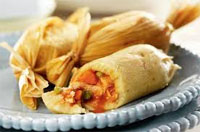 |
A Corn-Wrapped Tamal |
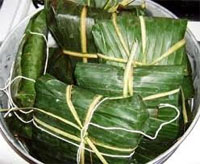 |
A Banana Wrapped Tamal |
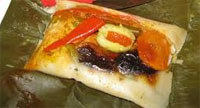 |
Dude! |
Once the masa dough is made it has to be filled or formed around something. I always thought a tamal is a tamal is a tamal but I couldn't have been more wrong. Here are some of the ingredients that have been used to stuff into the dough: red, green, yellow and black chiles, chocolate, fish, frog, tadpole, mushroom, rabbit, gopher, turkey, bee, egg, squash blossom, honey, ox, seeds and nuts.
There are white and red fruit tamales, white tamales, yellow tamales, dried meat tamales, roasted meat, stewed meat, bean and rice tamales, sweet sugar, pineapple, raisin, cinnamon, berry, banana and pumpkin tamales. There are hard and soft cheese tamales, roasted quail tamales, ant (that's creepy) tamales, potato, goat, wild boar, lamb and tomato tamales. Aztecs made worm tamales (that's crawly) and Mayans often used Iguana meat. There's plenty of room for creativity in both the fillings and how they are shaped.
Christmas-New Year's Week in Costa Rica is a time dominated by pork dishes of all kinds (including chicharrones). The tamales gift I received from my friend turned out to be a combination of pork and vegetables with just a touch of green chilies. I say that carefully and approvingly because I (and my stomach) personally don't like hotly spiced food. Fortunately for me neither do most Costa Ricans and the tamales I was given were definitely not highly spiced; just enough to give a background edge that enhanced the flavor. Five to ten minutes immersed in simmering water produced a nicely hot tamal with excellent flavor.
 |
Wanting to keep the adventure a Tico experience, I decided to enhance the tamal with a few drops of Salsa Lizano sprinkled over the steaming tamal. The taste of this sauce on Gallo Pinto (also known as Spotted Rooster) can be addictive (r r reeaallllly...). Ticos use it on many foods and, after living here six years, I now understand why. It added just the right touch of acidity, vinegar and savoryness to the tamal.
GG has become a convert to tamales, at least the Tico variety. Count me in for the pork, fruit and veggie based varieties (but hold the ones made of ants and worms). If you want to try your hand at making this creative and delicious food, here's a good recipe for a pork tamal: http://www.pbs.org/food/recipes/pork-tamales/.
Enjoy!
¡Pura Vida y Buen Provecho!
Visiting the Nicoya
(No Revenge in This Montezuma)
One of the things in GG's bucket list to do in Costa Rica was exploring the Nicoya peninsula. So recently, a visiting friend from Oregon and I headed out for a four day jaunt, this time intending to visit only the southern portion of the peninsula. The northern part would wait for another trip.
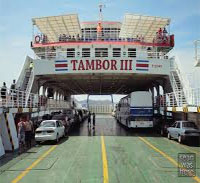 |
We rented a Toyota Yaris in Quepos and left by 8 AM on a Friday, intending to take a ferry from Puntarenas to Paquera, a small town on the southeastern coast of the peninsula. We made the 11 AM ferry in time to spare, negotiating the ticket lines and loading the car onto the Tambor III Ferry. This boat isn't the size or caliber of a mega-ferry like the Francisco but it is modern, clean and comfortable. It appears to have enough room for 50 or so cars on two decks plus about 200 people.
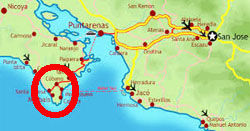 |
The Southern Nicoya |
The cost of the ferry for the car plus driver is 12,300 colones or abut $23, the extra passenger was an additional 900 colones ($1.65); total for the three of us: less than $25. The trip was about 20 kilometers, took 65 minutes and passed by a number of islands lining Nicoya Bay that offered some remote and pristine looking beaches that could only be approached by boat, which GG found intriguing. I kept thinking: your own beach with calm waters, yes! (Later I would learn that one of these islands was the infamous prisoner island of San Lucas - more on this next month.)
After disembarking in Paquera we took the main (and only drivable) road towards Tambor, which is a beach area about half way from Paquera to Montezuma. We had a hotel reservation in Montezuma but seeing a sign for the Barceló Resort Hotel in Tambor, I suggested we stop for lunch.
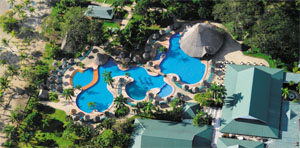 |
Barceló Tambor Beach |
Barceló is a Spanish based company with over 100 hotels in 17 countries, particularly latin countries. Regular double rooms here are posted at about $170 per night, more than we wanted to spend; besides, we wanted to discover the real Nicoya peninsula. We had a quick buffet lunch, gawked at the literally hundreds of guests and the beach, then continued on to Montezuma, arriving about 45 minutes later.
Up to that point we had experienced paved roads, albeit with some sections having a moderate amount of potholes, all the way to the town of Cóbano, which is seven kilometers north of Montezuma. Then, the last 6 km or so from Cóbano to Montezuma turned into a gravel road, although it was pretty flat and well graded. GG was thinking of dismissing all those stories he had heard about bad roads in the Nicoya. Not so fast, gilded one. It wouldn't be until the next day that the stories would be proven true.
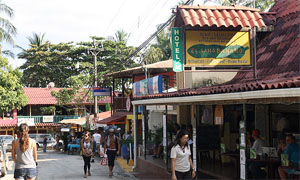 |
Montezuma "Centro" |
We checked into our hotel which turned out to be very near the small center of the town but situated a good hike up nearly vertical steps above the town level. The German-born owner, a charming lady, and her two sons who run the place "vur wery hauppy to zee us". We felt comfortable quickly. Ja, exzellent!
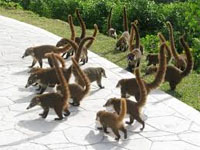 |
A Family of Coati |
The hotel was actually a hostel which included a common kitchen, common housing for some by way of a dorm room and uncommon things that creeped around at night (I presume these were animals and not guests). Our private room was up another flight of steep stairs above reception. It was clean and comfortable, there was a private bath, no A/C, no TV, no telephone - the real Costa Rica. One time we were sitting on a veranda of the hotel when we spotted what seemed like bushy monkey tails. Turned out to be a family of coati(mundi), which are kind of like raccoons but more gentle (perhaps). (see What's-in-a-Word below for more on the Coatimundi)
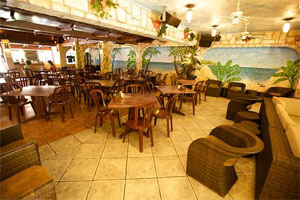 |
El Sano Bonano - The Movie Screen is Folded into the Ceiling Left and Descends at 7:30 PM Each Night |
We stayed close to the hotel the first afternoon and night, wandering by foot around the town which is very easy to do as going from one corner of the town to the opposite couldn't be more than 500 meters. At the suggestion of the hotel we ended up the first night at a nice little restaurant near the main beach called Cocólores. I had a piece of fish in a great red curry sauce... (ok, hold it GG, this isn't a ROMEO review). We would come to try two more restaurants before the end of our visit (El Sano Banano and Puggo's) that also were pleasant and offered interesting features and/or good food. Puggo's is reviewed below in the ROMEO section.
El Sano Banano was doubly interesting as it offered movies with dinner or dessert and we got to see The Interview, the movie that brought Sony to it's electronic knees at the hands of North Korea, as well as Lucy, a sci-fi thriller about a lady who accidentally gets turned on by a mysterious powder that renders her brain usage at the 100% level versus the normal (men too) use level of 10% (I've met women like Lucy who think they've taken this powder). Both movies were lots of fun; the food was good but not outstanding.
The next day the Dynamic Duo in the Yaris decided to explore southern Nicoya. After a few minutes study of the meager map we had acquired from the internet, we plotted to go from Montezuma southwest to Cabo Blanco (the southern most tip of the Nicoya peninsula - see map below) then north through Malpais (literally translated as "bad country" and well-named as far as the roads go) then to Santa Teresa and finally to Manzanillo. Even our map said that a passable way further north, at least by the coast road, ended just above Manzanillo.
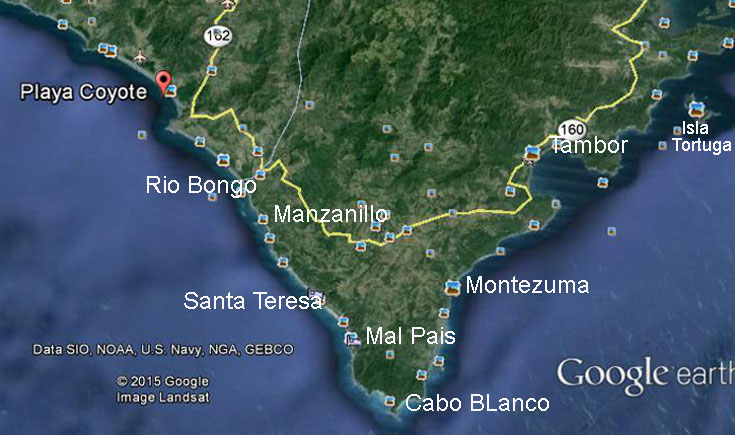 |
The road reverted to gravel shortly outside of Montezuma. On the way to Cabo Blanco we would occasionally encounter a patch of asphalt but there were many, many potholes to avoid. Eventually we found Cabo Blanco national park after negotiating a rather rough access road about one kilometer off the main road. The park offered three walking trails: A. 20 minutes, B. one hour and a half and C. four hours, all with the same (very basic) map. I decided on A, the 20 minute leg but managed to even wander off that route and was admonished by a ranger that I needed to go back (cocodrilos about the place maybe?).
After Cabo Blanco we headed north along what we thought was the coast road - slowly. These are very poor secondary roads, often with ruts and heavy stones in the middle of the road (we bottomed out the Yaris four times). We learned that crossing a flowing stream is often required where there are no bridges and we did so four times. We would pull up to a stream, get out to try to determine what route to take through the water and then wait for a 4x4 to come by to pick the best way, then follow their route. To get an idea of the kind of driving that's typical in this area, take a look at a You-Tube video (3 mins) posted by International Living: Driving in the Nicoya. And this video is mild compared to what we encountered in some places. Even though we actually crossed four streams that had no bridge we balked at one that looked just too dangerous so we circled back.
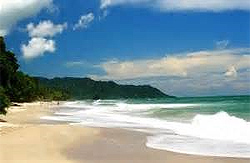 |
Santa Teresa |
We eventually managed to pass the towns of Malpais, Santa Teresa and we came near Manzanillo. Basically the west coast of southern Nicoya is very rugged, beautiful and a surfer's paradise (not so sure about us old dudes in that surf though). After several tries to find Ruta 160, the main drag back to Montezuma via Cóbano, and two warnings from locals that warned us that one route we wanted to take was impassable due to what they described as "rio alto" (high river - probably the Rio Bongo), we found the route (no thanks to signs anywhere) and motored back to Cóbano, then to Montezuma exhausted.
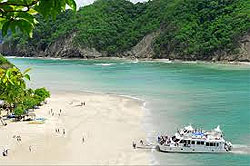 |
Isla Tortuga |
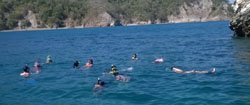 |
Some of Our Group Snorkeling |
The next day we signed up for a tour of Isla Tortuga, a 50 minute speedboat ride from Montezuma. It left about 9:30 AM, took us up the coast past Tambor where we had lunch the first day and then to one of the most beautiful islands in the Nicoya. This is the island destination that the ill-fated catamaran from Jacó that capsized two days earlier and killed three had intended to reach. We were more fortunate.
Only two families are permitted to live on Isla Tortuga and they are the caretakers of this sizable island. White sand beaches, turquoise water and an abundant variety of tropical fish and coral make this place ideal for swimming and snorkeling. Several of our group decided to go snorkeling and our boat driver and guide took them out a few hundred yards to a small outcropping of rocks where the tropical fish were plentiful.
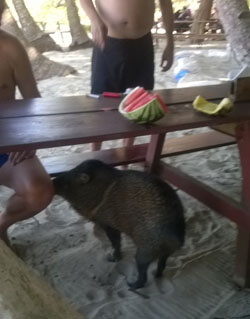 |
Beatriz the Peccary |
The families living on Isla Tortuga raise some livestock like chickens (strange looking ones with thick feathers and black, furry legs) and pigs. One of the pigs, a peccary by the name of Beatriz, wandered up to us and was very friendly. I made the mistake of petting her for a while and I guess we bonded; as she slept at my feet while I ate lunch. Friendly little porker.
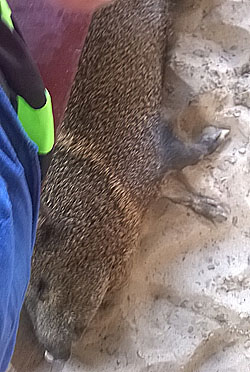 |
Beatriz Sleeping at My Feet |
The company that ran the tour (Zuma Tours) had a shelter and cooking area where they prepared a lunch for us consisting of our selection of chicken or fish (don't remember if peccary was on the list) and vegetables. For dessert we had fresh pineapple and watermelon - very healthy.
After lunch we had a couple of hours free time and the golden one went swimming at the main beach. Interesting to GG was the seemingly colder water there than what he experiences at Manuel Antonio. My guess was that the water temp was 4-6 degrees Fahrenheit less than at home (down all the way to 78-9F). Now, why would that be; it's really not that much farther north as the fish swims? We were then ferried back to Montezuma in time for the 4 PM scheduled arrival. Our last night there, we sampled a third restaurant in Montezuma called Puggo's that turned out to be quite interesting (see ROMEO section below).
We checked out on Monday with the intention of leaving Montezuma by 8 AM and hooking up with the ferry to Puntarenas at 11. As it turned out we got a jump on the day (old dudes get up early) and we were able to make the 9 AM ferry, the same ship (Tambor III) on which we came over. The view of the various islands again provided a beautiful and peaceful backdrop for the nearly one hour trip.
The southern Nicoya is truly an exceptionally beautiful and wild part of Costa Rica. In retrospect, however, GG would suggest to anyone planning to drive there, that you rent a 4x4 to make traversing the difficult terrain more manageable. Alternatively, if you just wanted to stay in Montezuma without wandering around the subcontinent, a speed boat can be taken that goes directly from Jacó to Montezuma in about an hour for $40. This is a different boat from the one that capsized.
¡Solo Bueno!
Statuesque San José
(An Interesting Walking Tour of Our Capital City)
MIchael Miller is a friend, a member of the Costa Rica Writer's Group, where I met him, and an accomplished author. He recently published an excellent English guide to downtown San Jose, the first of its kind here. The following excerpt from the guide about the treasures found on just one downtown avenue is published with Michael's permission. (Editor - GGC)
The Beguiling Bronzes of Fourth Avenue by Michael Miller
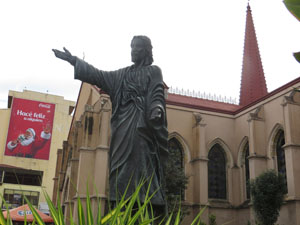 |
“Christ of the Highway” depicts a benevolent Jesus blessing travelers. Behind Him, Saint Nick appears to be waiving at Jesus. |
Avenida Cuatro (4th Avenue) in Downtown San José, Costa Rica is known as “The Other Pedestrian Walkway.” When compared to the more famous Avenida Central, which boasts the National Theater, the museums and many upscale shops, 4th Avenue is considerably more down-market, more working class.
But what might surprise you is the amount of public art that you will find on 4th Avenue. The 4th Avenue walkway boasts a number of fascinating statues. These pieces of public art make a walk down the Avenue well worth your time, and they are some of the wonderful surprises of Downtown San José.
Here are three of them:
At the western edge of the 4th Avenue Walkway is a beautiful church, called La Iglesia de Nuestra Señora de Merced. In a garden next to the church is a particularly eye-catching statue of Jesus. It shows Jesus standing with his arms outstretched facing the on-coming automobile traffic of the very busy intersection of Paseo Colon and Avenida 2. He appears to be blessing the travelers. The statue is called “Cristo del Camino” (Christ of the Highway).
The cross street is Calle 14 (14th Street).
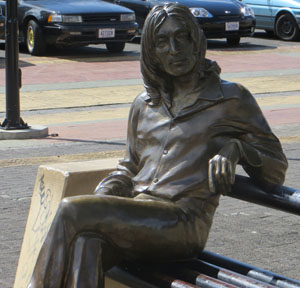 |
Beatle John Lennon awaits you to join him on a park bench. |
At the opposite end of the 4th Avenue Walkway, you will see another church. This one is called Iglesia la Soledad. Here you will find a small open plaza in front of the church with several park benches. Look at the benches. You will find a statue of a man sitting on one of the benches. The man is John Lennon. Beside him is a small brass plaque that contains a line, in Spanish, from the song “Imagine.”
Another way to find the John Lennon statue is to walk under the Chinese Arch on Avenida 2. The statue is one block south of the Arch. This has become a very popular spot, since you can sit next to the famous Beatle and get your picture taken.
The cross street is Calle 9 (9th Street).
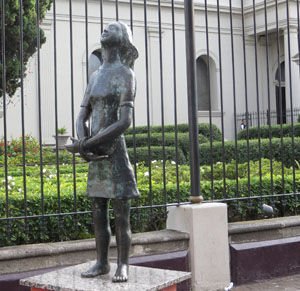 |
With hands bound, gazing heavenward, 15-year old Jewish girl, Anne Frank is led away by the Nazis. |
By far, the most poignant of the statues on 4th Avenue can be found next to the Cathedral Metropolitana. On the south side of the Cathedral, just outside the wrought iron fencing, there is a small inconspicuous statue of a young girl standing on a waist-high pedestal. Tens of thousands of people walk by this statue every day without ever noticing it. Or if they do notice it, most have no idea what it is or what it means.
The girl on the pedestal is looking heavenward, and if you look closely, you will see that her hands are bound. The girl is Anne Frank, the 15 year old Jewish girl who was led away by the Germans to a concentration camp. She later died in the Nazi death camps.
The statue was a gift from the people of Holland, a country that suffered greatly in World War II, to the peace-loving people of Costa Rica. It was presented by the Dutch embassy in 2008 to serve as a painful reminder of the horrors of Nazism. There was originally a plaque on the pedestal, but it has since disappeared.
The cross street is Calle Centro (Center Street).
Downtown San José is full of wonderful little gems. These are just three of them. They are all part of The Real San Jose.
- - -
Notes from the Editor:
* MIchael's walking guide suggests you walk along 4th Avenue from Center Street to 14th street (or vice versa) to view these three statues but that does not mean you need to walk 14 blocks. The peculiar street numbering system used in San José has even-numbered streets in one direction from Center Street ("0" Street) and odd numbers in the other direction so that walking from Center to 14th is really only seven blocks.
* Anne Frank was a child of a German Jewish family that moved from Frankfurt to Amsterdam in 1933 when Anne was four years old. In 1941, when the Nazis occupied Holland, Anne went into hiding and her parents constructed false walls in their home to hide Anne and others. In 1943 the family was betrayed by locals and Anne and her sister Margot were sent to Bergen-Belsen concentration camp where they died, probably of typhus, in 1945. Anne's diary was discovered after the war and it became a memorial to those that suffered the Nazi atrocity.
* GG had the opportunity years ago to visit the Anne Frank Huis in Amsterdam, the place where the girl was secluded for some time before being discovered by the Nazis. It is now a museum and is located two blocks from the Hotel Pulitzer on the Prinsengracht Canal where I stayed many times while doing business there. A visit to the museum will sober anyone and is highly recommended.
Many thanks to MIchael Miller for his thorough and very interesting description of one aspect of San José culture. To buy Michael's guidebook go here: The Real San Jose. And check out his website at www.therealsanjose.com.
¡Pura Vida!
Travel Quote of The Month |
|
What's-in-a-Word
Montezuma
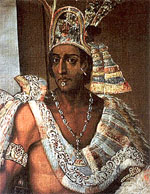 |
Montezuma II Chocoholic |
Montezuma is one common variant spelling of a historical name that also goes by Moctezuma, Moteczoma, Motecuhzoma, Moteuczomah or Mwatazuma. The word comes from the classical Nahuatl (Aztec) language and means "he who frowns like a lord" or "to frown in anger" or "he who is angry in a noble manner" (guess it's still better to be noble and angry that not).
There were two Aztec Emperors named Montezuma. Montezuma I reigned from 1440 to 1469 and Montezuma II reigned from 1502 to 1520. Most references are directed towards Monte II because his emperorship was during the onset of the Spanish conquest of Mexico. Moctezuma II had many wives (but only two queens), many concubines and children and reportedly drank as many as 100 cups of (unsweetened) chocolate (Xocolati) each day - I guess it must have been the first energy drink. After Hernan Cortez conquered Mexico, Zoomey was killed (the Spanish could be angry too).
Coati(mundi)
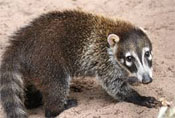 |
Coati(mundi) |
There are several types of this small animal (adults can weigh 6-18 lbs) related to the raccoon family. The ones we saw in Montezuma were evidently the ring-tailed variety as they have dark-colored rings that go completely around the tail (or is it the light rings that go around the dark tail - not sure, it's a zebra kind of thing). Coati have bear like claws and sharp teeth and, while they seem docile, it's probably a good idea not to irritate them.
Coati are ground scavengers but rest for safety in the niches of trees high in the canopy. They are omnivores and eat insects such as tarantulas and beetles and worms, fruit and local seafood like crabs, snails, clams and starfish. Nothing like a well balanced diet, is there.
Peccary
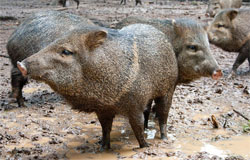 |
A (Smiling) Peccary |
Peccaries are found in the southwestern region of North America as well as in Central and South America. Adult peccaries can be fairly large and males can be over 4 feet in length and weight over 80 pounds.
Peccaries are also known as javelinas or skunk pigs. Funny, I didn't notice anything particularly smelly about Beatriz on Isla Tortuga but then my smeller has been largely destroyed by many years of smoking (but not for the last five years - yeh!). Evidently peccaries have a small gland at the base of their tails that they use to mark territory with a substance that smells somewhat like a skunk but isn't quite as strong.
A peccary is also an omnivore and will eat bugs, fruits, rodents and lizards. They have razor sharp teeth and have been known to seriously injure dogs, so approach with caution, they're not all as friendly as Beatriz.
Feral
So what's the difference between a house cat and a feral cat? Simply said, domestication, my dear, that's all.
As Wikipedia puts it: "For thousands of years, cats have been known for their ability to hunt mice and rats and keep their populations under control. ... free-ranging domestic cats (mostly unowned) are the top human-caused threat to wildlife in the United States, killing an estimated 1.3 to 4 billion birds and 6.3 to 22.3 billion mammals annually." The mammals talked about here are mice, shrews, voles, squirrels and rabbits.
GG had a cat growing up that could jump four or five feet into the air and pull down a seagull. No dogs messed with this pussy and it goes without saying that we never had a rodent problem even though we lived near a salt marsh where large rats were prevalent. Meeeeoooowww.
Uchuva Fruit
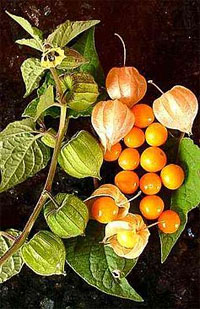 |
The ROMEO review of Puggo's below mentions a fruit called Uchuva because it was used to gracefully accent a dessert there. It's technical name is Physalis Peruviana (literally, peruvian bladder fruit). The bladder comes from the sheath or cocoon that covers the fruit. At the restaurant, the bladder was artfully peeled back to resemble a flower with the fruit at the center.
Uchuva is indigenous to South America but has been cultivated in places around the world since the late 18th century.
It's also known as Cape gooseberry (South Africa), Inca berry, Aztec berry, golden berry, giant ground cherry, African ground cherry, Peruvian ground cherry, pok-pok (Madagascar), poha (Hawaii), ras bhari (India), aquaymanto (Peru), uvilla (Ecuador), uchuva (Colombia), harankash (Egypt), amour en cage (France) and, simply, Physalis (United Kingdom).
The taste of the ripe fruit is sweet with a mildly tart accent - a perfect accompaniment for something like the frozen white chocolate mousse it was served with at the restaurant in Montezuma. To a norteamericano unfamiliar with this fruit like GG, the result from using it to accompany the mousse was exotic.
¡Solo Bueno!
ROMEO Corner
(Retired Old Men Eating Out)
Pollo Surfo, Quepos
Location: Boca Vieja, about one mile north of the one-lane bridge out of Quepos, directly across from the La Bomba gas station.
Hours: Lunch and Dinner Tuesday thru Sunday, Closed Mondays.
Parking: A couple of spaces in the back.
Contact: Tel.: N/A; Email: N/A; Website: N/A
Reviewing ROMEOS: Alma, Anita M., Chris F., Donald A. Lance M., Mark T., Mary M., Bob N.
To Review Our Rating System and Procedure, go here: R.O.M.E.O. Rating System
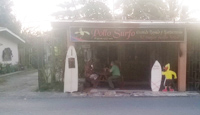 |
Pollo Surfo |
Pollo Surfo (liberally translated as "Surfing Chicken") is a typical example of a kind of restaurant in Costa Rica and particularly in this area called a "Soda".
The best equivalent GG can think of is what we used to call a "luncheonette" in the northeastern U.S. where I grew up, a small restaurant that serves a limited menu of locally popular items at reasonable, often bargain prices. Pollo surfo is precisely that. My guess is there is four to five dozen Sodas in the greater Quepos area.
You can see from the picture that the building is basic. The furnishings are heavy wood picnic tables with no ecoutriments (hard on some backs, like mine). The restaurant is separated from the busiest street into Quepos only by a narrow sidewalk, making noise and traffic obvious unless you sit as far back in the dining room as possible. For atmosphere we give Pollo Surfo two sloths.
The menu is also stereotypical Soda. Six to eight versions of arroz con something and six to eight versions where you take the fish or meat out of the arroz con something, move the rice to the sides, add beans and one or two starches like macaroni shells and call it a casado. These are simple but basically nutritious meals that feed a family but don't break the budget. Off menu on the night we visited they offered a swordfish steak (hmmm, I thought billfish were off limits?), a whole grilled snapper and a lomito (steak). GG and two others tried the swordfish steak. It was promised in a garlic sauce but I couldn't see the sauce and tasted but a hint of garlic leading me to believe it might have been grilled with a garlic oil but there was no sauce. The fish was fresh and tasty. Desert offering was also typical for a Soda, chocolate cake, chocolate cake with ice cream or ice cream. For food quality and variety we give Pollo Surfo three sloths. Several of us elected to take a gelato dessert downtown later. |
 |
|---|---|
$$$ |
|
Value Index = 100 |
Service was friendly and helpful even if it took almost 50 minutes to get our main courses. I noted that taxis arrived two different times during that period with small bags that went directly to the kitchen probably with fixins for our meal (now ain't that typical Soda! - I love this stuff). Three and a half sloths for service and an overall rating of three sloths for the restaurant.
For my swordfish (not a large piece) and a tamarindo fresco, my bill came to 7,345 colones with tax or about $14. That's cheap in this area and worth a cost rating of three $. Value index = 3/3/*100 = 100, in the middle of our rankings.
If you're on a budget and want to sample good and basic "comida tipica", a restaurant like Pollo Surfo is the place to go.
Puggo's, Montezuma
Location: 50 meters west from "Main Street", Montezuma on the main road towards Cabo Blanco.
Hours: Breakfast, Lunch, Dinner daily (late night dining available).
Parking: On the main road only.
Contact: Tel.: 506 2642 0308; Email: N/A; Website: N/A
Reviewing ROMEOS: Bob B., Bob N.
To Review Our Rating System and Procedure, go here: R.O.M.E.O. Rating System
This was the last restaurant we went to in Montezuma during our four day visit and the place surprised GG. It's run by an Israeli couple (two ladies), one the reputed chef (Puggo) and the other who acts as server and, it appears, the master organizer.
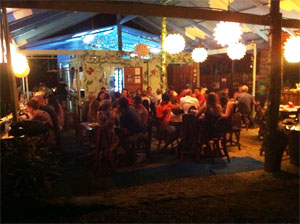 |
Puggo's Dining Room |
The restaurant is, in some ways, stereotypical Costa Rica with a dining room open to the atmosphere and hard wooden tables and chairs but in other ways it displays a more original and creative motif. For example, The "chandeliers" were home made by taking simple, clear plastic spheres and attaching pointed dixie cups all over them; one had to look closer to see that they were not expensive glass castings. That plus tasteful wall decorations make a very warm and comfortable dining room. Four sloths for atmosphere.
The menu too was interesting and different. Moroccan fish stew was there, which I regret not ordering (next time), kind of a north African bouillabaisse. In addition to several other mediterranean offerings and Israeli dishes, there is a generous menu of sushi.
But my eyes lighted on a special offering for the day - Moussaka, a good one of which I haven't had in years (when I used to make it - pardon the braggadocio). The server lady (sorry, I didn't get the name or don't remember it) apologized that they were unable to find lamb that day so the version they made was of ground beef rather than ground lamb. But in every other respect it was delicious, the eggplant fresh and tasty. It was accompanied by breaded, deep-fried cauliflower and a small julienne salad of beets and green onions. Outstanding tastes.
By the time we got to dessert, my interest in things different had been tweaked and I asked our hostess what she would suggest that might not be on the menu. The result was the concoction seen in the photo to the left. Frozen white chocolate mousse accompanied by two pieces of sweet, orange uchuva fruit, sprinkled with raisins and chopped coconut and drizzled with honey and almond oil. Add Turkish coffee for accompaniment. Zowie! |
 |
|
|---|---|---|
$$$1/2 |
||
Value Index = 4.5/3.5=129 |
For food quality I have to give Puggo's five sloths for creativity and taste.
The server lady was friendly, helpful, courteous and attentive. Four sloths for service and an overall rating of four and a half sloths for atmosphere, food quality and service.
The meal as described above came in at just over 10,000 colones with tax and required gratuity. That's just over $18 and a bargain in today's Costa Rica. Three and a half $ for cost rating yielding 4.5/3.5x100 = 129 on the Value Index, in the top third of our ratings.
If you find yourself in or near Montezuma and like to sample the not-so-usual, try Puggo's, you won't regret it.
Golden Gringo Chronicles E-Books and Hard Copy Novel Now Available!
A narrative version of the Golden Gringo Chronicles is now available as a trilogy of E-books in formats compatible with virtually all electronic platforms. Click on Part Number above for E-book sample downloads or click the price above right for purchase. (The best price is on Part 1; it's FREE)
The story of the Golden Gringo Chronicles is also available as a hard copy novel of 192 pages available through Amazon and all major online retailers. ($9.95) Amazon link: GGC, the Book. (Kindle Edition available) Follow GG through the first six years of his odyssey in making the decision to retire in Costa Rica, overcoming the trials and tribulations of moving and obtaining residency there and the fun and experience of actually living in Ticoland. Ride along with the Golden Gringo as he learns about the rich, varied culture of Costa Rica, the incredible bio diversity, the charming nature of the Costa Rican people and the ease with which a sometimes clueless ex-pat can assimilate into a small southwestern town on the Pacific coast. Whether you are already a Costa Rican resident, someone contemplating a move here or just a traveler who enjoys different cultures, you will find the Golden Gringo Chronicles interesting, entertaining and informative about Costa Rica. |
The Golden Gringo
Pura Vida! |
Be pithy but kind; I'm sensitive. |
|---|










